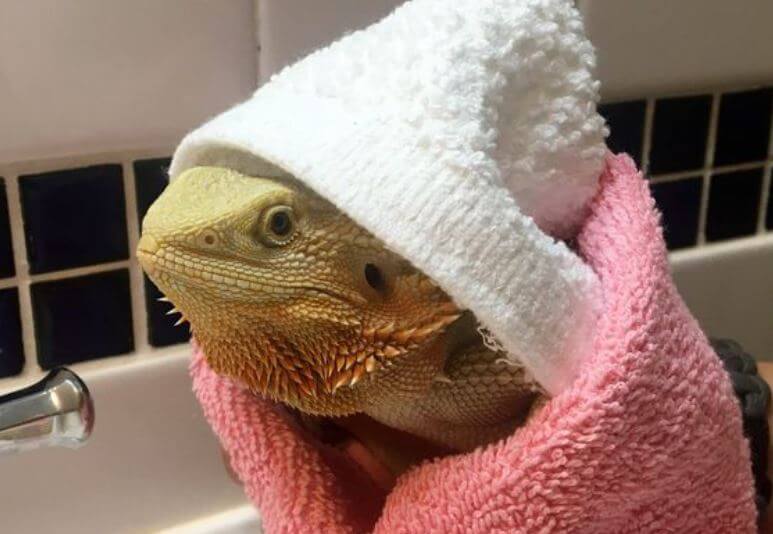Although being a very vigorous creature, bearded dragons also suffer from health issues. An unhealthy bearded dragon, instead of telling us what is the matter, may show signs or symptoms of an unsound condition.
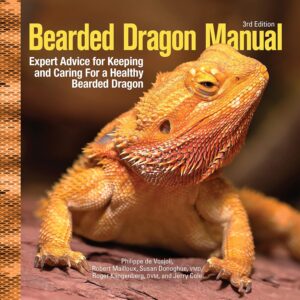 Therefore, as their caregiver, you had better pay great attention to any signs of an unhealthy bearded dragon as these signs could give clues or evidence about any possible illness or a disease that an unhealthy bearded dragon is going through so that you can find a good solution for these issues such changing its habitat or diet, visiting a reptile veterinarian and so on.
Therefore, as their caregiver, you had better pay great attention to any signs of an unhealthy bearded dragon as these signs could give clues or evidence about any possible illness or a disease that an unhealthy bearded dragon is going through so that you can find a good solution for these issues such changing its habitat or diet, visiting a reptile veterinarian and so on.
Below are signs of an unhealthy bearded dragon as well as some recommendations that you should know.
Related Posts:
- Can Two Bearded Dragons Live Together?
- How Do Bearded Dragons Sleep?
- Reasons Why Your Beardie Turned White and Died
- Bearded Dragon Hissing at Me
- Why Is Your Bearded Dragon’s Beard Black?
30+ Signs of an Unhealthy Bearded Dragon You Must Know
1. Lethargic
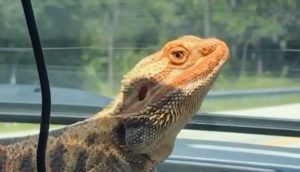
An unhealthy bearded dragon may look quite sluggish or lethargic due to several common reasons such as a deficient diet, uncomfortable environment, or internal parasites.
Also, low environmental temperatures can be considered a common cause as this can result in loss of appetite.
Regarding a young beardie, a basking area temperature of between 95°F to 110°F with a cooler region of around 80°F to 90°F is recommended.
One circumstance you don’t need to worry about is that many beardies may bromate or hibernate when the season changes from summer into fall and then into winter.
This will reduce the bearded dragon’s appetite as well as its activity levels.
Therefore, you had better keep offering food and water as well as maintaining proper temperatures and light cycles.
Recommendations:
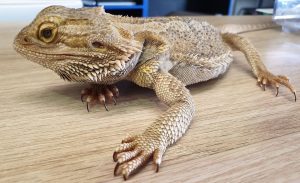
To monitor temperatures within the terrarium, a high-quality thermometer like a Zoo Med Thermometer/Hygrometer Dual Gauge is highly recommended.
You had better use two measuring tools- one put in the basking area and the other located in the cooler area in order that you can check and control the complete temperature gradient in the habitat.
If you need to modify temperatures, you can have a larger or smaller wattage basking bulb added while a mercury vapor bulb is quite ideal as it can provide both radiant heat and UV radiation.
If there is nothing wrong with the temperature or your dragon is not in the period of brumation time, and he is still acting lethargic, it’s time for you to consult a reptile veterinarian.
2. Damaged Snout/Bloody
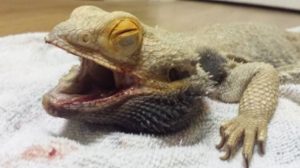
The common reason for a bloody damaged-looking snout is snout rubbing as a beardie is kept in a too-small enclosure for its size.
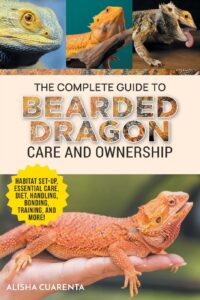 Also, they can try to find a way out of the enclosure, which can hurt their snout and make it bloody and raw.
Also, they can try to find a way out of the enclosure, which can hurt their snout and make it bloody and raw.
You can remedy this by giving the beardie an adequate enclosure, a well-balanced, and varied diet.
You can interact with the beardie by taking him out of the habitat occasionally for entertaining activities.
In specific, you can take him for a walk with a special lizard leash or allow the beardie to sit in your lap to explore a safe room for 30 minutes to an hour a couple of times per week.
Snout rubbing may be an indication of stress so you should give him an appropriate hide box, and monitor terrarium temperatures.
3. Malnourished Appearance/Bony, Underweight, or Skinny
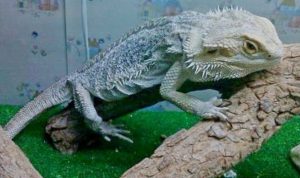
There are many reasons for a bony, malnourished appearance of an unhealthy bearded dragon.
Looking skinny, underweight, or losing weight might be a sign that your reptile is sick, gets unhealthy diets, or bad lighting and heating.
Also, an unhealthy bearded dragon not eating obviously can cause weight loss.
Sick bearded dragon signs:
- Sunken fat pads on the back, below their eyes
- Clear ribs
- Loose skin not caused by shedding
- Weighing less
- Head appearing bigger
Recommendations:
To cure the weight loss, go for a vet search for some diseases like adenovirus, respiratory infection, yellow fungus, parasites, cancer, etc. will cause weight loss.
Secondly, ensure you know what to feed a sick bearded dragon with the best food and in the right portions.
A little bit more gut-loaded feeder insects including crickets, roaches, silkworms, and other staple feeder insects can help the pet gain weight.
In addition, you can encourage or stimulate your beardie to eat well by varying its diet as much as possible as well as providing enough food items with calcium powder.
Thirdly, ensure you have the right heat lamps and UV light as these two are important in digestion and vitamin D3 synthesis.
In order for your beardie to get exposed to adequate UV radiation, you can use a Repti Glo 10.0 fluorescent bulb or equivalent products that are suitable for desert-dwelling reptiles.
You should monitor terrarium temperatures by using a quality reptile thermometer.
Last but not least, ask a qualified reptile veterinarian for advice.
Related Posts:
- Can Beardies Eat Rosemary?
- Can Beardies Eat Brussel Sprouts?
- Do Beardies Eat Peas?
- Can Beardies Eat Squash?
- Can Beardies Eat Pears?
4. Discolored Stomach
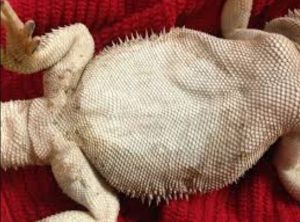
Unhealthy bearded dragons suffering from stress will have a darkened or black stomach.
In specific, beardie has been brought to a new home or experienced environmental changes.
Also, it is the feeder insect left in the habitat overnight or the incorrect temperature that causes your beardie stressed.
Recommendations:
When being in a new home, a beardie is more likely to feel unsafe, strange, and scared.
Therefore, you had better give it time to get accustomed to the new surroundings.
In specific, you should provide it a good hiding place in an attempt to reduce stress as much as possible.
Also, you should avoid annoying your beardie except for regular feedings and cleaning.
And you should gradually increase contact at a slow pace to avoid stressing the beardie.
Monitoring temperatures regularly to make sure that they are not too low or too high.
Otherwise, temperatures can cause undue stress for the reptile.
Regarding feeder insects, you do not want your beardie to be crawled on and bitten by them. This makes your pet stressed.
Therefore, you had better remove uneaten feeders after 15 – 20 minutes after feeding.
5. Disfigured Tail or Limbs/Brittle Bones
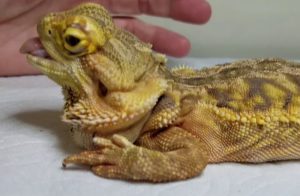
A drop or other impacts can lead to tail, or limb disfigurement among beardies while weak or brittle bones can indicate a sign of Metabolic Bone Disease.
In case the end of the tail becomes black and dead-looking, it must be a bacterial infection called tail rot.
Recommendations:
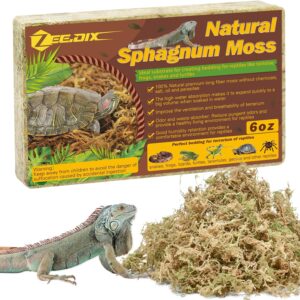 In case of a broken bone, you had better seek a veterinarian immediately for x-rays and diagnosis. Besides, a blood test will be performed to check calcium levels.
In case of a broken bone, you had better seek a veterinarian immediately for x-rays and diagnosis. Besides, a blood test will be performed to check calcium levels.
Before visiting the veterinarian, you should use ice and gently massage the area of the suspected broken bone to help reduce swelling.
Tail rot is extremely dangerous as it causes the section of the tail to turn black and fall off.
And it even gradually moves up the tail and enters the body, which leads to death.
The only way is to seek a veterinarian for antibiotic treatment as soon as possible.
You can minimize the opportunities of possible tail rot by taking these steps.
Firstly, keep husbandry conditions sanitary by having the terrarium cleaned regularly with an anti-microbial cleaner safe for pets such as Healthy Habitat.
Secondly, leaving feeder insects in the terrarium for long periods of time or at night.
Because crickets will chew on the bearded dragon’s tail.
Last but not least, provide the BD with a warm bath at least once per week to keep the skin clean and supple.
6. Eyes Look Cloudy/Filmy
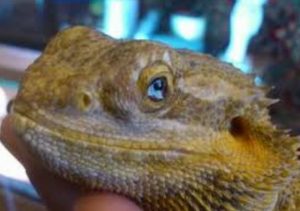
A strong and healthy bearded dragon will have transparent, bright, and active eyes.
Meanwhile, unhealthy bearded dragons may have dull or dark eyes, which may simply relate to a shedding issue.
However, it would be more serious like an infection or a disease if you notice any discharge coming from their eyes.
That is also the reason why you should buy a BD having clear, bright, and alert eyes.
Recommendations:
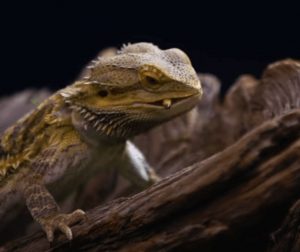
In case of a shedding issue, you should follow some steps for your BD to shed his skin easily.
You should prepare warm water for your BD to bathe in and relax for about 15 – 20 minutes.
Meanwhile, you can make his head and face wet by using a small cup to gently pour water over without getting water in his eyes or nostrils.
For the better process of losing the skin and promoting healthy shedding, we recommend you use Zoo Med Repti Shedding Aid or Zilla Bath Shed Ease, and remember to keep eyes away from any bath solution.
On the other hand, if the signs mentioned before don’t come from a shedding issue, you had better visit a reptile veterinarian as soon as possible.
7. Mouth Rot or Discolored
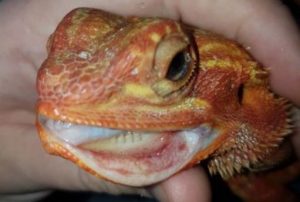
A bacterial infection can have an impact on the mouth and gums of a beardie, which results in mouth rot or decay.
That is the reason why you can see the symptom of a faded, or blackened mouth of unhealthy bearded dragons.
Two main culprits to blame for this are unsanitary conditions and low temperatures, and only a reptile veterinarian can have ways to treat mouth rot.
Recommendations:
To prevent this issue, you should have a routine cleaning schedule and follow it strictly.
In specific, you should have the terrarium, all decor items, and food/water dishes cleaned and tidied regularly.
Make sure that you use a cleaning solution without any toxic chemicals for reptiles such as Healthy Habitat.
Monitoring the temperature and humidity levels within the terrarium is also very important, and you can try using a good thermometer/humidity gauge.
In case temperatures are cooler than normal, you can use a basking bulb or heat lamp with a higher wattage.
8. Shaking Head/Jerky
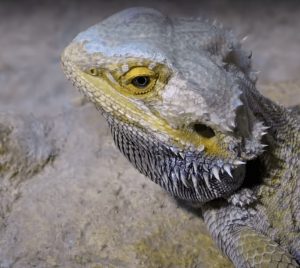
When your BD is showing jerky or shaky behavior, this may be commonly due to calcium and vitamin D3 deficiencies as they need calcium for strong bones and vitamin D3 so as to absorb calcium.
Besides, A possible culprit resulting in jerky, shaky behavior may be a neurological disorder.
Recommendations:
You had better give your bearded dragon adequate UV lighting as UV radiation plays an important role in producing vitamin D3 that backs up the absorption of calcium in the bloodstream to boost good skeletal development.
Besides, UV radiation also functions to promote a healthy appetite and brain function.
If your BD keeps showing shaky, jerky behavior, you had better perform further examination from a veterinarian for a complete diagnosis.
9. Loss of Appetite
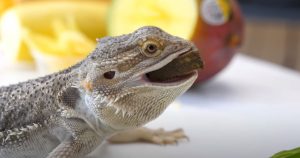
Among signs of an unhealthy bearded dragon of appetite is the most common symptom and it is hard to find out the reason as it varies from inadequate temperatures to stress.
Therefore, we must make use of our best observation and judgment according to conditions.
Recommendations:
Firstly, you should have the habitat temperatures checked to wonder whether they are in the proper ranges for the age of BD you have.
If nothing wrong with the temperatures, the amount of UV radiation provided should be considered.
There are many reasons for making your beardie stressed.
The first reason is the radical terrarium setting changes, which can cause the most stressful times for the pet to adapt to the new home.
And the reactions will vary following different personalities of BD as some BD are not worried about the change while others may freak out.
Therefore, in this situation, you had better give him/her time to adjust and only disturb him/her when absolutely necessary.
Another reason causing some stress is leaving live feeders in the terrarium overnight for a long period of time.
If you have tried all ways mentioned before and your BD is still not eating well, the only way is to find the advice of a reptile veterinarian for other possible health issues such as impaction or Metabolic Bone Disease.
10. Mouth Hanging Open
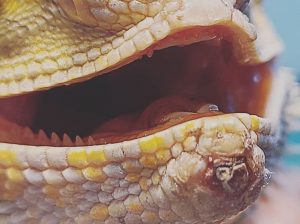
A slack jaw is the most common symptom of Metabolic Bone Disease. This means the bearded dragon’s mouth keeps opening and it has difficulties taking the food.
The best way is to seek a reptile veterinarian immediately to have your BD tested for Metabolic Bone Disease.
In specific, a blood test may be performed to evaluate calcium levels in the blood.
However, in case the BD opens its mouth while being on the basking perch for short periods of time. It will be normal as this allow your beardie to cool off while directly under the basking bulb.
And you can easily see this similar behavior in dogs as their pants cool off.
Recommendations:
Besides seeking a reptile veterinarian, you should offer soft foods that are easy to be swallowed to the beardie such as baby food or soft wax worms.
Providing adequate UV radiation regularly will help prevent slack jaw or Metabolic Bone Disease. Some products specially designed for desert-dwelling reptiles are mercury vapor bulb or fluorescent bulbs. And, you also need to dust food items with calcium powder before feeding.
11. Obesity
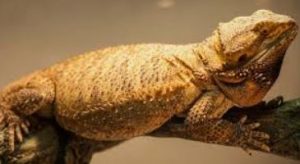
In the wild, being a very active creature, beardie loves having physical activities. Meanwhile, beardie raised in captivity has little room to be active like their wild counterparts. This coupled with a poor diet can eventually lead to obesity. This is one of the signs of an unhealthy bearded dragon.
Recommendations:
To minimize the chances of obesity of adult BD, you should provide a balanced diet of nutritious feeder insects and wholesome fruits and vegetables, such as gut-load feeder insects.
Additionally, you should have all the food items dusted with good calcium powder before feeding your BD.
However, make sure that you don’t feed your beardie insects high in fat content such as wax worms.
Besides a good diet, it is important to encourage your BD to do a little exercise at least once per week.
For example, you can take the BD out of the terrarium for a short walk during warm weather and let him/her explore the room.
Related Posts:
- Can Beardies Eat Honeydew Melon?
- Do Beardies Eat Dill?
- Can Beardies Eat Radish Greens?
- Can Beardies Eat Chard?
12. Runny, Soft, or Foul Stool
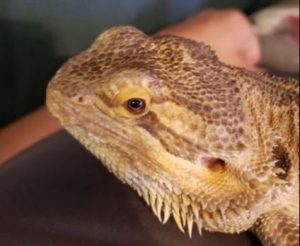
A soft or runny stool is also one of the signs of an unhealthy bearded dragon.
This happens when your beardie has a possible internal parasite or an insufficient diet.
Another reason is feeding your beardie lettuce, which results in runny stool and causes malnutrition.
While a yellow-tinged urate (the end of the poop that is usually white) can indicate the sign of dehydration.
And a red or rusty-colored urate could be caused by parasites.
A runny stool or temporary diarrhea could also be an indication of stress that a beardie may suffer from.
Recommendations:
Preparing a proper diet and avoiding feeding lettuce is the best guide as lettuce contains a lot of water instead of nutritional value.
This can cause diarrhea and dehydration.
Regarding internal parasites, feeder insects in contaminated conditions are the main culprits.
Therefore, you had better choose fresh and strong feeders.
Especially, you don’t hesitate to search for a trustworthy feeder supplier.
Cleaning and sanitizing your beardie’s habitat regularly plays an important role.
In specific, you should have the entire terrarium and any decor uncluttered at least once per month with a quality terrarium cleaner, and to minimize the number of bacteria, you should clean any spills or soiled areas.
However, make sure that you do not use any household cleaners containing strong chemicals such as Windex.
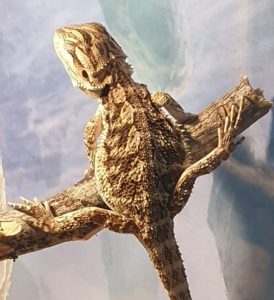
As a yellow tint urate indicates a hydration issue, it is very important to keep your BD hydrated by misting your BD twice per day with clean, dechlorinated water.
In case you use tap water, you should have the water treated with a water conditioner.
This helps remove chlorine, ammonia, heavy metals, and other chemicals.
A great product you can consider is Zoo Med ReptiSafe. You just lightly mist the BD and it will slowly lap the water off the end of the nose.
Another efficient way is to give the beardie a bath in clean, dechlorinated water at least once a week.
This helps keep the beardie hydrated and allows it to shed his skin easily.
Also, it works in case of light constipation or small impaction issues.
In case your BD gets stressed, which leads to temporary diarrhea as he is quite strange to his new home.
Therefore, you should give your BD time to adjust, and prepare a place for him to shelter for security.
Sometimes, your BD keeps showing the symptom of abnormal stool or sustained diarrhea.
You had better get help from your veterinarian to perform a fecal exam.
And, you can find out the exact reason as well as check for parasites and possible treatments.
13. Sunken Eyes
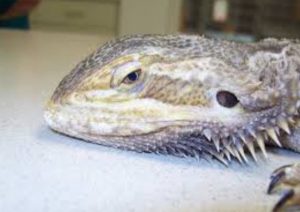
Another sign of an unhealthy bearded dragon is sunken eyes.
That may be the consequence of a possible infection or dehydration.
In this case, you should give the beardie a bath in warm dechlorinated water which is just shallow to avoid drowning, and make sure you keep an eye on him during baths.
It is very important to supply fresh, dechlorinated water on a daily basis.
You also can mist beardie a couple of times per day by gently spritzing water onto the bearded dragon’s head. And it will lap up drips of water from its nose as you mist.
14. Swollen Limbs and Tail
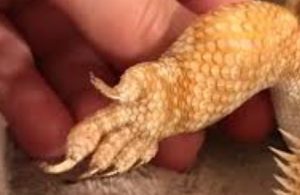
There are several reasons for swollen limbs or tails seen in unhealthy bearded dragons.
Firstly, this can be an indication of a cracked or broken limb/tail.
This comes from a fall or a battle between some beardie.
Metabolic Bone Disease is also seen as the culprit that leads to fractured or broken limbs or a tail.
Another reason for this sign of an unhealthy bearded dragon is a bacterial infection such as tail rot.
Recommendations:
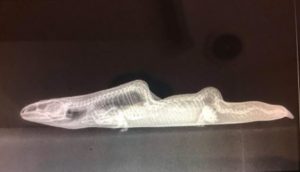
If your BD shows such symptoms, you should immediately visit a qualified veterinarian to perform x-rays and some kind of tests. This is the best way to find out the exact reason and have proper treatment.
If it is more likely to be Metabolic Bone Disease, only a qualified veterinarian can help to treat it. This is a life-threatening disease immediately.
You can take some steps below to minimize the risk of Metabolic Bone Disease with your BD.
First and foremost, give your dragon adequate UV radiation by using reptile-specific bulbs.
And the one we highly recommend is Zoo Med ReptiSun 10.0 UVB Fluorescent Bulb or the Exo Terra Solar Glo Mercury Vapor Bulb for superior UV radiation output for beardies.
Secondly, food items with calcium powder such as Repashy Calcium Plus should be used to dust insects and plant matter liberally at each feeding.
15. No Droppings or Loose Droppings
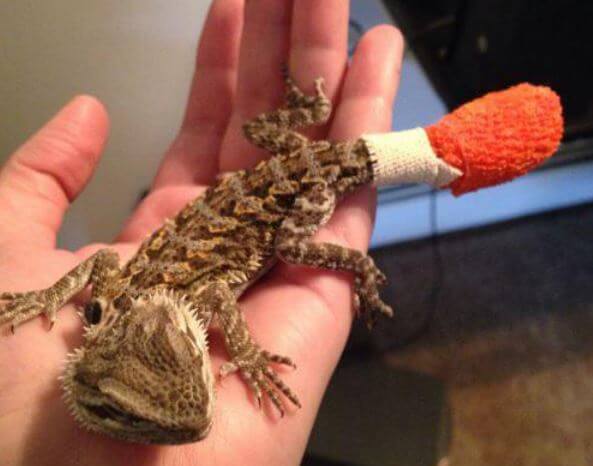
Adult bearded dragons poop every 1 to 7 days. If they start stretching longer, that may be a symptom of impaction or constipation.
Sick bearded dragon poop longer and unpredictable. If this is not correctly relieved, your pet can be seriously injured.
On the other hand, loose droppings tell that your pet may have some digestive issues at that moment.
Sometimes it is also because of more severe problems like dehydration or parasites.
Recommendations:
How to take care of a sick bearded dragon? Luckily, this problem can be fixed easily.
Offering him a bath, warm water preferably will help the dragon a lot. You can provide a dish of water inside his tank for him to do the task on his own.
However, take a stool sample and try to find a vet if he does not cure himself quickly.
16. Paralysis
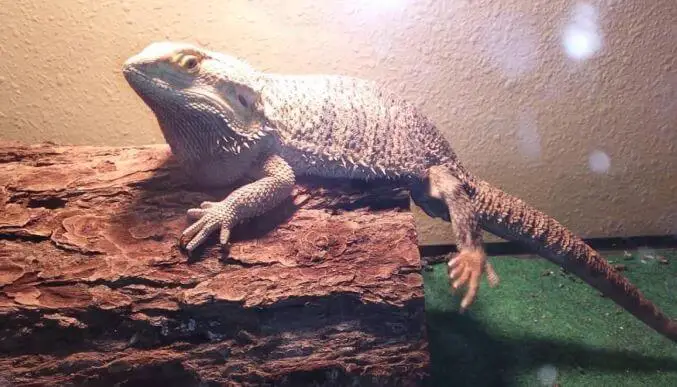
Paralysis potentially takes place for a number of causes associated with metabolic bone disease.
This is one of the most dangerous diseases you and your bearded dragon might face as it always implies a bigger problem.
This problem can come from eating food from unsafe or unreliable suppliers.
In a vivarium or artificial living environment, your pet drinks water from what you provide.
If this water source is not clean or you do not replace it frequently, he can get parasites as well.
Recommendations:
If the beardy drags or positions his limbs in a strange way, you should hop in action as quickly as possible before it gets more serious.
Try to touch the limb or parts of his body to see whether if he is suffering from paralysis.
If he does not move, it is possible that he is paralyzed.
As a consequence, we suggest you make an appointment with the vet right after you find the animal being difficult to lift or drag the limbs.
17. Sunken Fat Pads
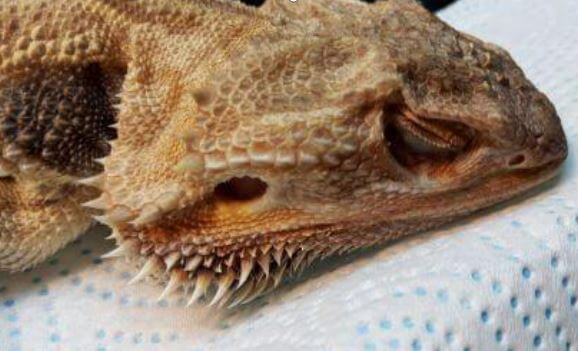
Fat pads are the squishy soft region behind the eyes that includes the extra fat of a bearded dragon.
It is usually an induction when they are sunken that your pet is underweight.
You can look behind each of his eyes to find his fat pads.
Two small raised soft skin patches can be seen from there.
Healthy dragons are notably raised with fat pads.
On the order hand, sick dragons can be riddled with fat pads which are either sunken or nearly flat.
The first warning that the dragon is malnourished or dehydrated.
Recommendations:
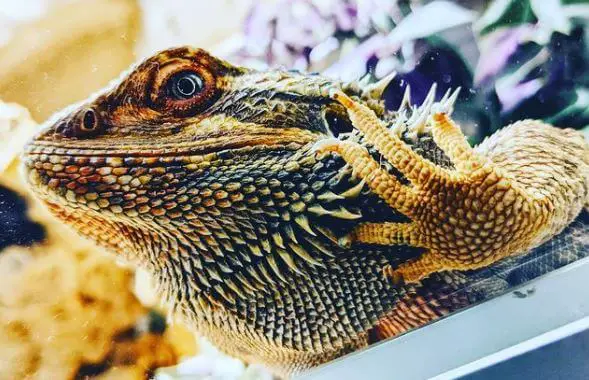
Are the cage mates harassing your beardie?
Remember to not hold them as a party because bearded dragons like to be alone.
They also lack food if they are locked in the same enclosure.
Stress immensely impacts the immune system.
It could be a simple problem, like just an illness, if your pet looks too skinny.
In case of any, a poop test shows the more serious problem.
Your vet will have an accurate medication.
18. Wrinkly Skin
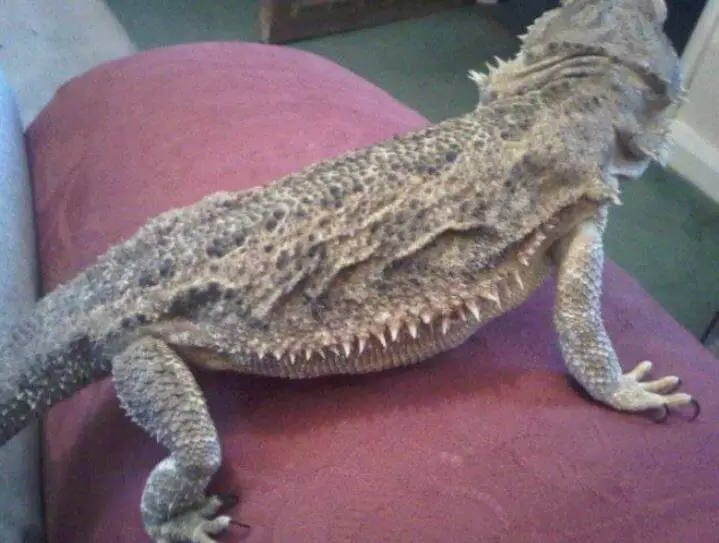
It is important to understand that many bearded dragons have wrinkles because their skin just can not stretch as much as most other species.
If the dragon’s tail is a decent size and their fat pads are not indented, odds are a little wrinkly skin is not much to fret about.
However, if the tail is scrawny and the fat pads are indented, wrinkly skin could be an indication that your dragon is underweight.
Many times this can be a sign of dehydration, particularly if appeared with a urate (the white part of their stool) that is hard and chalky.
If so, you will need to improve his hydration.
Recommendations:
In this situation, you will need to fatten them up.
I suggest adding more protein into their diet (feeders) and also give them supplement such as Fluker’s Carnivore High AMP Boost Supplement to boost their appetite.
If you think your pet is not underweight but they still have wrinkly skin, it may mean that they are dehydrated.
If so, simply hydrate them by helping them to bathe, provide clean water and adjust the humidity inside the tank.
19. Rotting and Discolored Skin
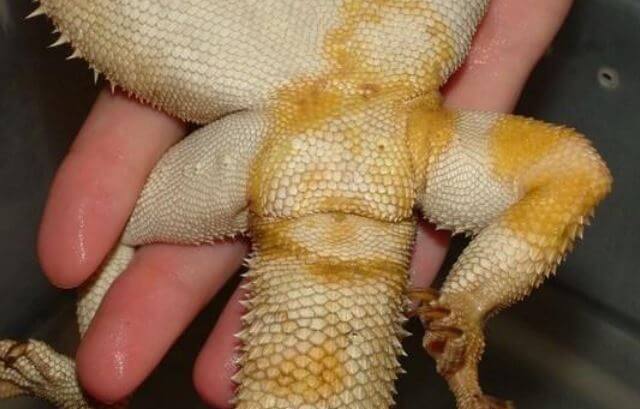
When your unhealthy bearded dragon gets rotting or discolored skin, it can be hard to ignore and will sadly be the result of many different problems.
First and foremost, if their skin appears to be decaying on the black, it is likely your beardie may be suffering from tail rot, which can lead to the loss of a tail or death the extreme cases.
If they tend to have decaying skin that exposes inflamed and infected wounds, it may be attributed to yellow fungus, which is an infectious fungal infection that affects both the superficial and deep tissues.
Recommendations:
If you think the lizard has a yellow fungus, take them to the vet as soon as possible.
If not, it may either be that they have a few bruises on their scales or are having a rough shed.
Please note that If after 3 days the rot or wound does not seem to be any better, take him to the clinic for a checkup and this may be due to something more severe, and need proper antibiotics.
A pro tip: You think he is having a rough shed?
Help their scales recover by adding a few drops of betadine iodine to a dampened cotton pad and applying it on the hurt spots once daily, followed by an antibacterial cream.
Or you should literally only add raw unpasteurized honey once a day.
20. Dehydrated
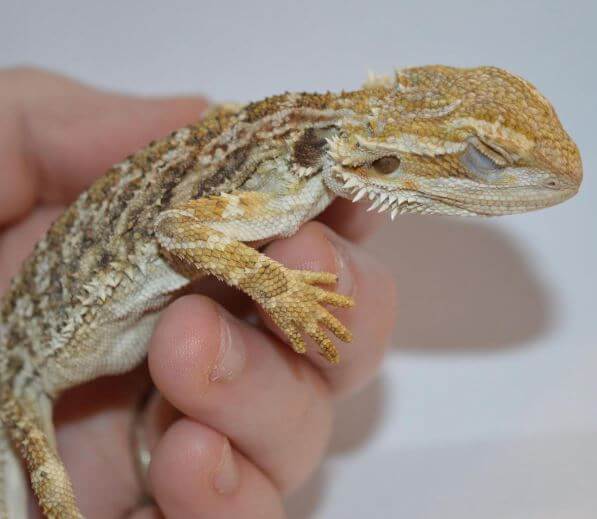
Keeping a bearded dragon well hydrated is vital for their wellbeing.
Hydration is one of the most important factors that keep your pet away from illness.
There are some signs of dehydration you should notice:
- Sunken eyes
- Perks up after drinking water
- Wrinkled skin
- Lack of appetite
- Lack of energy, do not want to move
Recommendations:
One method you can measure to see if your pet is dehydrated is softly pinching their skin with your fingertips (where the skin normally loses).
If the skin keeps its form after you let go for a few moments (instead of quickly going back to place) then he is most likely dehydrated.
If you think he is dehydrated then you ought to continue to help him to drink water, Pedialyte, or sports drinks like Powerade (diluted 1:1 in water).
You can try to encourage him drinks water first by offering them fresh water, then if it does not help you should try using an eye dropper or a small syringe without the needle.
21. Atadenovirus
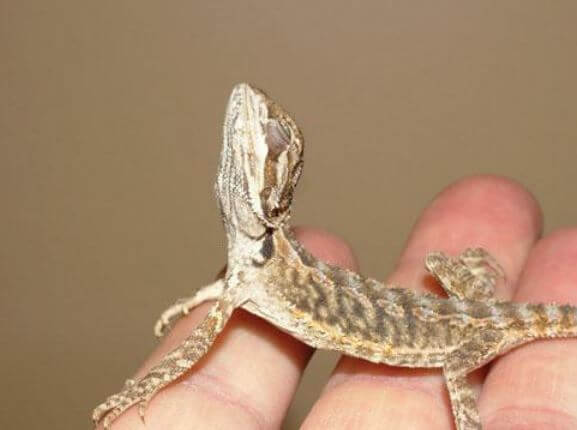
Adenovirus or atadenovirus is a life threatening disease that is extremely infectious among reptiles.
It normally infects newborn or juvenile bearded dragons.
Adults may contract it as well, although it appears to be rarer among them.
Atadenovirus is normally lethal to infant unhealthy bearded dragons.
Infected babies will usually die within 90 days.
The cause of death from atadenovirus is typically liver failure or multiple organ failure.
If the infant does manage to survive the illness, it will still be a carrier for life.
For this reason, it should not be housed among atadenovirus negative reptiles.
Recommendations:
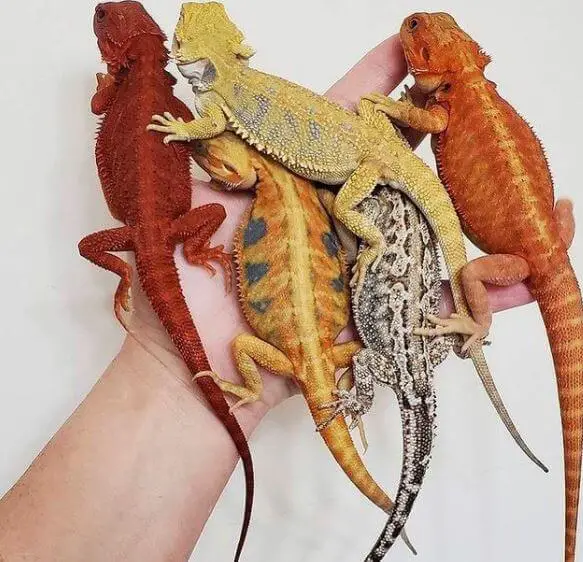
To find out whether your beardie has atadenovirus, the vet will prescribe a fecal swab for PCR testing (which looks for virus DNA).
Most owners are suspicious of expenses involved with testing for viruses in their lizards, but tests must be performed to prove the virus in the body.
Unluckily, there is no treatment for atadenovirus.
A dragon with ADV should only be managed to relieve its symptoms.
It can be kept alone to avoid further contamination of other beards and reduce its competition with other beardies for food.
It will continue to require adequate UVB lighting and heat.
If it has a secondary infection due to a suppressed immune system, antibiotics can be prescribed.
If the beardie is dehydrated, warm water soaks may be recommended, and syringe feeding may also be appropriate if it is not eating well.
22. Respiratory Tract Infection
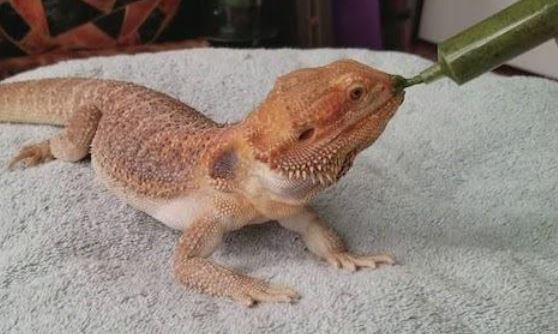
An unhealthy bearded dragon may develop respiratory tract infection (often abbreviated to RTI or RI) for a variety of reasons but they all come down to something wrong with the living environment or husbandry.
Usually, an RTI is due to the temperature being too low or the humidity being too high, but the aspiration of water of food may instead be a culprit.
Aspiration is more of a concern if you are syringe feeding the dragon or supplying water by a syringe directly through their mouths.
They can aspirate when drinking from a regular water supply too.
A respiratory infection can be lethal for your reptile if the husbandry is not fixed and the infection treated.
Recommendations:

To prevent the chance of getting a respiratory infection, you need to pay attention to your beardie’s living environment:
Make sure that the humidity levels are fall between 30% and 40%, never exceed higher.
Too much moisture can harm their inept lungs.
Temperature also needs to be maintained, be specific for each different area of the setup.
Do not make him stress.
It is essential to understand the potential stress they could be under and how to help them to overcome it.
Clean and disinfect his tank frequently, at least every3 months, but once a month is suggested if you have time.
This will help to remove the mold and other nastiness that grow inside the tank.
However, if you suspect that your pet is suffering from RI, thus, certainly the first step in action should be to get them to the vet as soon as possible.
23. Burn Out
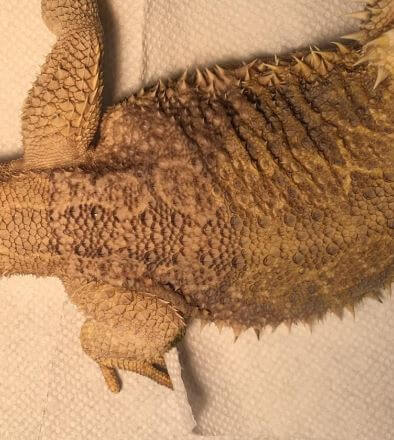
While it is definitely not an illness in itself, we consider it prudent to include the risk of burns in this list since there are many people who do not know better which has caused serious burns to their dragons.
Burns may happen for a variety of causes and will appear as an area of skin that is inflamed, likely gone white or yellow with pus—like exudate, look like burns of humans.
Burns will occur on your dragon’s underside, which is usually the most common area since they do not sense heat properly through their bellies.
It can also appear on their arms, limbs, toes, and tails, however.
Recommendations:
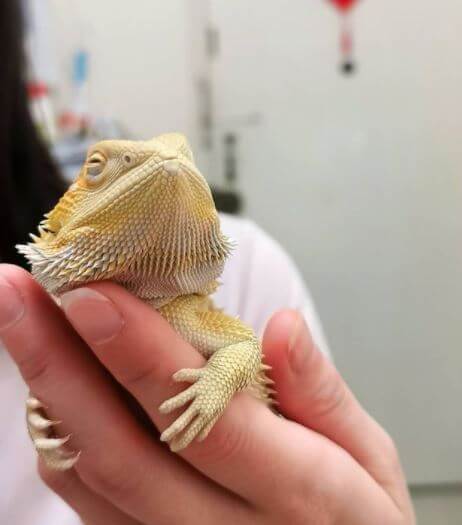
Whilst this might seem obvious, the only way to avoid burns is to ensure that your bearded dragon cannot come into contact with something hot.
Be careful though that even a comparatively low temperature (50 to 60 Celsius degrees) will cause burns if the dragon is exposed to it for a long enough time.
It is for this reason that we do not suggest the use of heat mats for example.
Heat mats are very suitable for other reptiles, but not for bearded dragons.
Moreover, ideally, all the heat lamps should be located at the very top of the vivarium, with a hole cut to just the same size such that a heat lamp does not require a protective cage.
It is a special injury that needs special treatments.
In an emergency, we will consider cooling the burnt areas with tepid (not cold) clean water on a cotton wool ball, change the water periodically to keep it cool.
Do not add some ointment or creams until told by the vet to do this.
24. Hypervitaminosis (Over-supplementing)
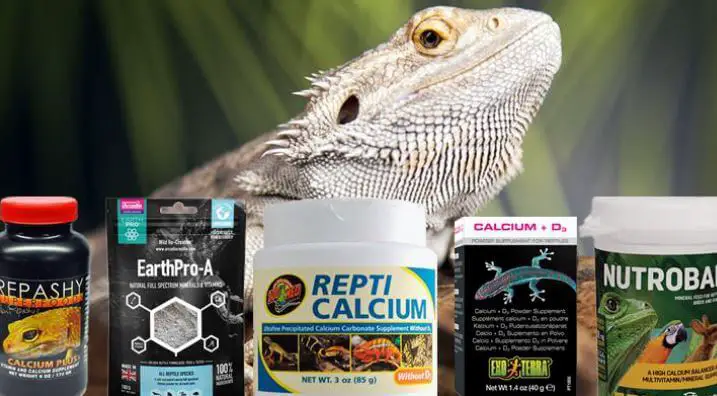
This hypervitaminosis is relatively rare but is becoming more common.
Hypervitaminosis in bearded dragons happens when they consume too many supplementary nutrients.
This is typically vitamin D but has been known to be vitamin A.
The fat soluble vitamins (A, D, E, K) can all build up in a bearded dragon’s environment which contrary to the belief that ‘all vitamins are good’ can cause toxicity issues.
The water soluble vitamins (B, C) do not do this since they are excreted readily if there is too much in the system.
Recommendations:
Unfortunately, previous administration of vitamin can not be reversed.
Thus, the treatment of hypervitaminosis is usually supportive and requires avoidance of secondary skin infections.
Decreasing and possibly discontinuing vitamin intake or usage is necessary.
Reptiles with chronic hypervitaminosis require long-term care and wound treatment as well as regular check ups.
If vitamin supplementation is warranted, it is best to give a fat soluble than a water soluble formulation since water based vitamins can be consumed more easily and thus potentially be more harmful.
25. Yellow Fungus Infection
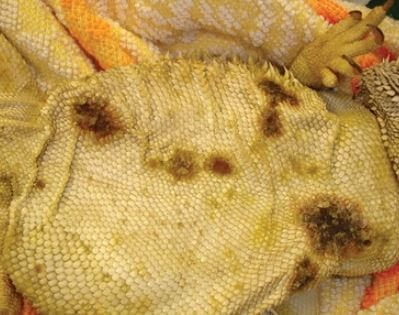
Yellow fungus infection is, as it suggests, a disease caused by a fungal infection.
Infection is becoming more popular lately and is transmitted by direct contact with bearded dragons.
It can also be transmitted between reptiles who have been in a vivarium that has housed an infected one.
Along with the normal symptoms of elevated lethargy and being off their diet, an unhealthy bearded dragon with a yellow fungal infection would show the signs elsewhere on their body.
A yellowy discoloration of their skin (which gives rise to the diseases alternate name of Yellow Skin Disease) can be the first skin symptoms and if left untreated it will develop to painful ulcers beneath their scales which can eventually force the scales off and lead to ugly painful skin lesions.
These lesions will also contain pus and can produce a discharge.
Recommendations:
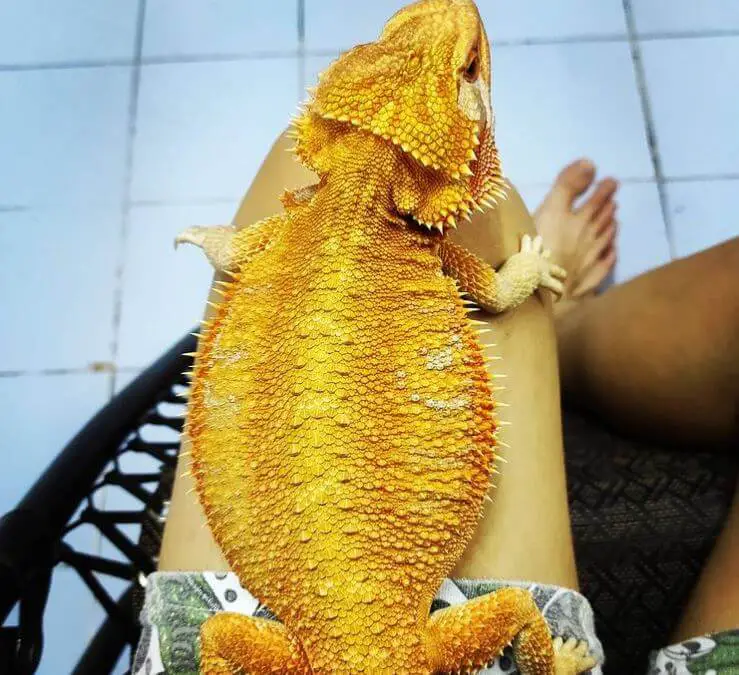
The yellow fungus is difficult to handle but is nonetheless treatable.
But this condition is going to take a visit to the reptile vets for effective anti-fungal treatment.
The sooner your unhealthy bearded dragon sees the vet, the faster and healthier they can make a recovery.
There will be less harmful to your wall as well.
You will need to treat them with oral antifungals.
You will also need to inject by dropping some through their mouths with the use of a syringe.
It will require to use of topical ointments to help reduce the infection and inflammation.
Read More:
26. Gastrointestinal Infection
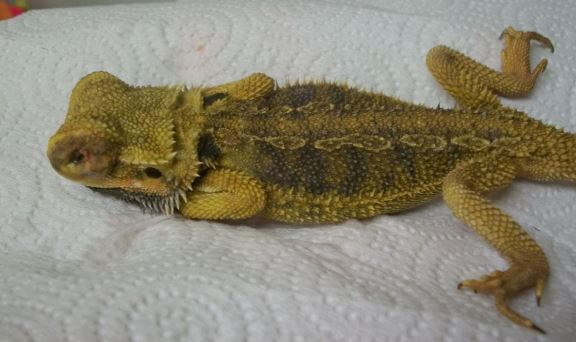
What is the sick bearded dragon behavior caused by a gastrointestinal infection?
A large range of pathogens may cause beardies to emit loose, foul-smelling, watery, or blood-laden stools.
Any of these infectious agents can also induce dehydration, lack of appetite, lethargy, or weight loss.
Recommendations:
While an isolated intestinal condition may be of no cause for concern, persistent complaints require veterinary treatment.
The vet would usually take blood from the lizard to assess the causal reason, and administer a medication that will help him heal.
Some intestinal parasites, like many roundworms, are reasonably simple to handle, whereas others, such as many protozoal species, can need prolonged efforts and experimentation.
27. Green, Yellow, Black, or Red Poop
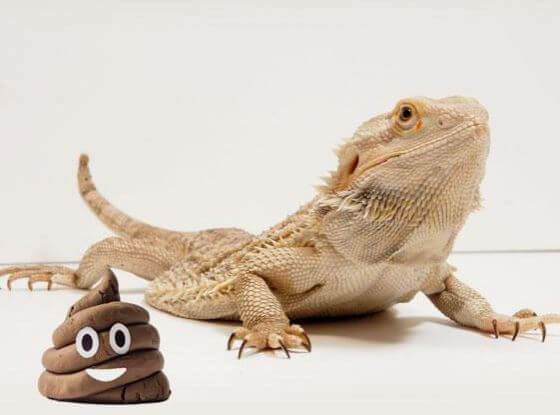
The color of unhealthy bearded dragon might vary slighting depending on their diet, medication, etc.
For instance, leafy greens high in chlorophyll can cause the poop to appear greenish while yellow veggies make it look yellowish.
Similarly, black bugs will make it darker or black.
A bloody appearance may be attributed to food color, parasites, impaction, polyps, and so on, whereas all white may suggest the presence of urates with no fecal matter.
However, do not confuse urates with eggs.
Recommendations:
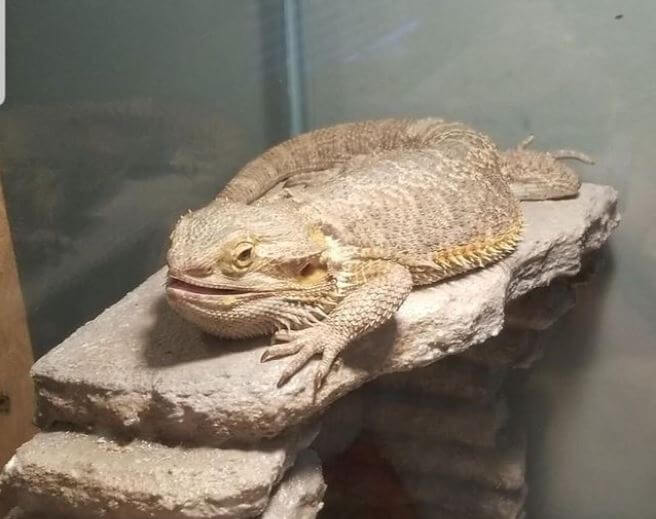
If the color-changing poop is not a temporary issue and continues for longer than two days, you may need to get them to the clinic because diarrhea will easily weaken them.
The vet may get a fresh sample of the poop for performing various tests to determine the cause.
Treatments will largely depend on what diagnosis indicates as the issue.
Moreover, dietary changes, correct UVA and UVB light, temperature settings (these influence digestion), mitigating stress by proper husbandry including cleaning and disinfecting their décor or furniture as well as their terrarium, food, and water bowl, and so on may help control diarrhea.
Often, ensure feeder insect handling and growing happens hygienically because they can bear parasites too.
You can try Exo Terra Calcium and D3 Powder Supplement for helping them to restore their healthy flora.
28. Vomiting or Throwing Up

An unhealthy bearded dragon can vomit, throw up or puke clear fluid, the food they just ate, such as crickets, mealworms, super worms, silkworms, and so on.
Often, their vomit can be bloodstained, have a disgusting smell, and it occurs for different reasons:
- Low tank temperature
- Impaction
- Internal parasites
- Overeating, oversized or toxic food
- Drink too much water
Recommendations:
First and foremost, whether your beardie has thrown up more than once or is coughing up vomit, mucus, or refuses to eat, you need to get them to the vet asap.
Also, collect some of the vomit and store it in a jar in the fridge to take to the vet as well.
He will be able to take it and run tests to decide what is the reason.
29. Limping and Hunched or Distorted Posture
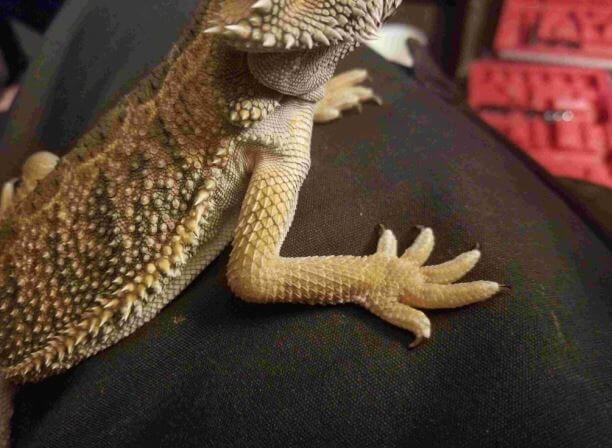
Besides a distorted posture and body parts, like bones, the beardie can falter or have a jerky movement.
In addition, he might be unable to lift his legs (hind and forelimbs) well, bear his tail as usual or stand on his legs or walk, and so on.
These symptoms can result from paralysis, including partial paralysis, metabolic bone disease, impaction, constipation, bone diseases like bone tumors.
Furthermore, physical injuries, including on limp or spine, as well as other diseases and disorders, can also cause it.
Recommendations:
As many factors can trigger jerky motions and a distorted pose, see your vet for advice.
You should make sure their living environment has the right UV light and temperature, and they have the correct diet dusted with multivitamins and calcium.
30. Abnormal Breathing (Labored, Shallow, Rapid)
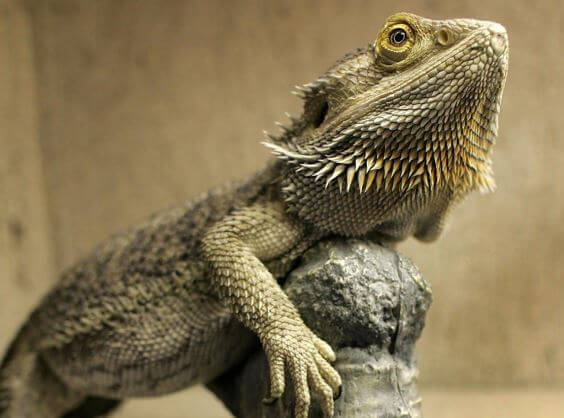
Typically, it occurs when there is shallow, quick, or difficulty in breathing, as well as open-mouth breathing which can appear alongside other symptoms including coughing and choking noise, a puffed throat, runny nose, etc.
The key culprit responsible for breathing problems is respiratory infections, which may be due to bacterial, infections, or fungal infections.
However, stress, wrong humidity content, and other diseases and conditions can make your pet breathe abnormally.
Recommendations:
First of all, check the temperature and humidity inside the tank.
Ensure you keep the relative humidity between 30 % and 45 %.
If not, you can try changing the living environment to see if he can relax.
Then, check what your pet has eaten recently, maybe he ate something big that takes him a long time to digest.
If all of these do not help, ask the vet for advice.
Conclusion
In conclusion, there are many signs of an unhealthy bearded dragon that you should know. And it is very important to pay attention to any signs or issues. If you have any doubts, don’t hesitate to take him to a qualified veterinarian for periodic exams.
Because they are completely capable of examining and treating the most unhealthy symptoms mentioned before. I hope that you will find it useful and knowledgeable to give your bearded dragons all the best things.
Remember these signs of an unhealthy bearded dragon
Bearded dragons are popular reptile pets known for their hardy nature and captivating personalities. However, like any pet, they can develop health issues. It’s crucial for bearded dragon owners to be aware of the signs of an unhealthy bearded dragon to ensure their well-being. Here are some key indicators of an unhealthy bearded dragon:
1. Weight Loss:
- A noticeable decrease in body weight may indicate an underlying health problem.
- Check for sunken eyes and a pronounced spine as signs of weight loss.
2. Lethargy:
- A healthy bearded dragon should be active and alert.
- Lethargy or excessive sleepiness could be a sign of illness.
3. Discolored Skin:
- Abnormal coloration, such as a dark, blackish hue, can signal stress or an internal issue.
- A healthy bearded dragon should have vibrant, well-hydrated skin.
4. Poor Appetite:
- A sudden loss of appetite or reluctance to eat may indicate a digestive issue or illness.
- Bearded dragons are typically voracious eaters when healthy.
5. Respiratory Distress:
- Wheezing, labored breathing, or gaping (keeping their mouth open) can be signs of respiratory infections.
- A healthy bearded dragon should breathe quietly and without effort.
6. Swollen Limbs or Joints:
- Swelling in the limbs or joints may suggest metabolic bone disease (MBD).
- MBD can result from improper diet, inadequate UVB exposure, or calcium deficiencies.
7. Abnormal Stool:
- Diarrhea, constipation, or blood in the stool are clear indicators of digestive issues.
- Healthy bearded dragon feces should be well-formed and not excessively foul-smelling.
8. Dehydration:
- Sunken eyes, wrinkled skin, or excessive skin tenting when gently pinched are signs of dehydration.
- Bearded dragons require access to fresh water at all times.
9. Parasites:
- Bearded dragons can suffer from internal parasites like worms or protozoa.
- Symptoms include weight loss, lethargy, and irregular stools.
10. Aggressive Behavior:
- A normally docile bearded dragon that suddenly becomes aggressive may be experiencing discomfort or illness.
- Aggression can manifest as biting, tail twitching, or tail puffing.
11. Shedding Problems:
- Difficult or incomplete sheds can lead to retained shed skin, which may constrict blood flow or harbor bacteria.
- Maintain proper humidity levels to facilitate shedding.
12. Infections and Sores:
- Look for open wounds, abscesses, or visible infections.
- Any suspicious wounds should be addressed promptly.
If you observe any of these signs in your bearded dragon, it’s important to consult a veterinarian with reptile expertise. Regular veterinary check-ups and proper husbandry practices, such as maintaining appropriate temperature and lighting, providing a balanced diet, and ensuring a clean environment, can go a long way in preventing and addressing health issues in your bearded dragon. Being attentive to these indicators and acting swiftly can help keep your bearded dragon happy and healthy.
Further Reading:
- Carolina Custom Cages Terrarium Review
- 10 Best Thermometers for Beardie: How to Choose the Best One?
- 5 Best Beardie Lighting Setups for Beardie Lovers
- 9 Best Heat Lamps for Beardie: Natural Habitat Provided

